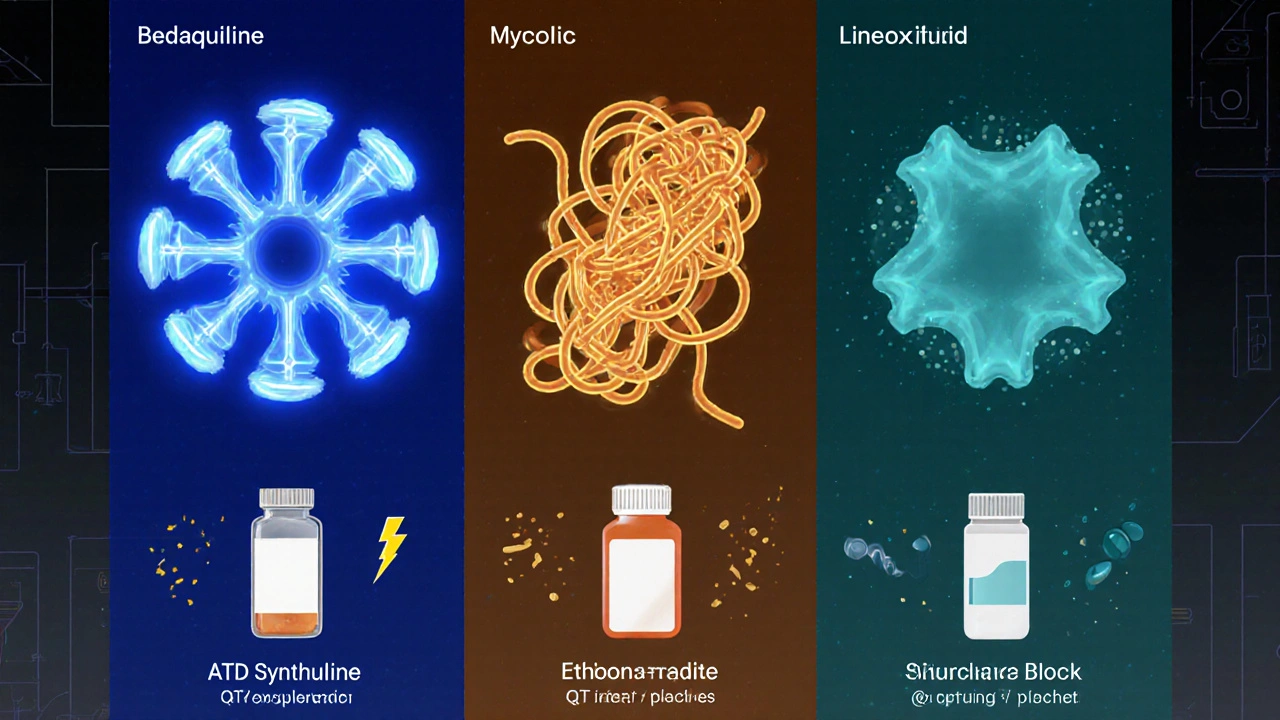TB Drug Comparison Tool
Trecator SC (Ethionamide): A second-line oral agent used primarily for drug-resistant tuberculosis. Blocks mycolic acid synthesis, but has notable GI and CNS side effects.
Alternatives: Bedaquiline, Delamanid, Linezolid, Cycloserine, Clofazimine, Levofloxacin - each with distinct mechanisms, dosing, and side effect profiles.
| Drug | Mechanism | Dosage | Side Effects | Cost (USD/month) | Availability |
|---|
Decision-Making Guide
Consider susceptibility tests, patient tolerability, and resource availability when selecting a regimen.
Quick Summary
- Ethionamide (Trecator SC) is a second‑line oral agent used mainly for drug‑resistant tuberculosis.
- It works by blocking mycolic‑acid synthesis, but its GI and CNS side‑effects are common.
- Newer agents such as bedaquiline and delamanid offer better tolerability but are often pricier and limited to specific resistance patterns.
- Choosing the right drug depends on susceptibility test results, patient comorbidities, cost, and national procurement policies.
- Combination therapy remains essential; no single drug can replace a full MDR‑TB regimen.
What is Trecator SC?
When you see Trecator SC is the brand name for Ethionamide, an oral antibiotic classified as a second‑line anti‑tuberculosis (TB) drug. It was first approved in the 1960s and has been a staple in multidrug‑resistant (MDR) TB regimens for decades. Ethionamide disrupts the synthesis of mycolic acids, essential components of the mycobacterial cell wall, leading to bacterial death.
The usual adult dose is 15-20mg/kg per day, split into two doses, and therapy typically lasts 6-12months depending on the overall regimen. Because Ethionamide is metabolized in the liver, clinicians monitor liver enzymes regularly. Common adverse reactions include nausea, vomiting, abdominal pain, and a characteristic peripheral neuropathy that may require vitamin B6 supplementation.
How Ethionamide Works - The Pharmacology in Plain English
Ethionamide is a pro‑drug; once inside the Mycobacterium tuberculosis cell, it is activated by the bacterial enzyme EthA. The activated form then binds to the enoyl‑ACP reductase (InhA), halting the elongation step of mycolic‑acid production. Without a robust cell wall, the bacteria become vulnerable to host defenses and other antibiotics in the regimen.
Because its activation depends on a bacterial enzyme, mutations in the ethA gene can confer resistance. This is why susceptibility testing is vital before deploying Ethionamide in a regimen.

Top Alternatives to Ethionamide
In recent years, several newer agents have entered the MDR‑TB toolbox. Each brings a distinct mechanism, dosing schedule, and side‑effect profile.
- Bedaquiline - a diarylquinoline that targets the ATP synthase of the bacterium, offering rapid bactericidal activity.
- Delamanid - a nitro‑imidazooxazole that blocks mycolic‑acid synthesis via a different enzymatic route.
- Linezolid - an oxazolidinone that inhibits protein synthesis; useful for resistant strains but may cause bone‑marrow suppression.
- Cycloserine - a cyclic antibiotic that interferes with cell‑wall peptidoglycan cross‑linking, often causing neuropsychiatric effects.
- Clofazimine - originally an anti‑leprosy drug, now repurposed for TB; known for skin discoloration.
- Levofloxacin - a fluoroquinolone that inhibits DNA gyrase, widely available but resistance is rising.
Side‑by‑Side Comparison
| Brand/Generic | Mechanism | Typical Dose | Common Side Effects | Cost (USD/month) | Availability (2025) |
|---|---|---|---|---|---|
| Trecator SC (Ethionamide) | InhA inhibition (mycolic‑acid synthesis) | 15-20mg/kg daily, divided BID | GI upset, peripheral neuropathy, hepatotoxicity | ≈30 | Widely stocked in national TB programs |
| Bedaquiline | ATP synthase inhibition | 400mg loading, then 200mg three times weekly | QT prolongation, hepatic rise | ≈1,200 | Limited to referral centers, WHO‑endorsed |
| Delamanid | Mycolic‑acid synthesis blockade (different pathway) | 100mg BID | QT prolongation, nausea | ≈1,000 | Available in high‑burden countries under WHO program |
| Linezolid | Protein synthesis inhibition (30S ribosomal subunit) | 600mg daily | Peripheral neuropathy, anemia, thrombocytopenia | ≈250 | Global supply, but monitoring required |
| Cycloserine | Inhibits cell‑wall peptidoglycan synthesis | 500mg BID | Depression, seizures, GI distress | ≈35 | Common in MDR‑TB regimens, variable quality |
| Clofazimine | Redox cycling, generates reactive oxygen species | 100mg daily | Skin discoloration, GI upset | ≈50 | Increasingly included in WHO‑recommended regimens |
| Levofloxacin | DNA gyrase inhibition | 750mg daily | Tendinitis, QT prolongation, GI upset | ≈20 | Broadly available, resistance rising |
Decision‑Making Criteria
When you sit down with a patient or a TB program manager, ask these three questions:
- What does the susceptibility test say? If the isolate is resistant to fluoroquinolones, levofloxacin drops out; if it harbors an inhA mutation, Ethionamide may be ineffective.
- Can the patient tolerate the side‑effect profile? Patients with pre‑existing neuropathy may struggle with Ethionamide or Linezolid, while those with cardiac arrhythmias should avoid QT‑prolonging agents like bedaquiline.
- What resources are on the table? In low‑resource settings, cheap drugs like Ethionamide, Cycloserine, and Clofazimine are often the only realistic options, whereas high‑income programs can afford bedaquiline or delamanid.
Balancing these factors yields a regimen that is both effective and sustainable for the patient.
Pros and Cons of Trecator SC
Pros
- Low cost makes it accessible in most national TB programs.
- Oral administration simplifies directly observed therapy (DOT).
- Long track record provides ample safety data.
Cons
- High incidence of gastrointestinal upset and peripheral neuropathy, often requiring pyridoxine.
- Hepatotoxicity can limit use in patients with liver disease.
- Resistance can emerge quickly if the inhA promoter is mutated.

Best‑Fit Scenarios for Ethionamide
If you’re treating a patient with confirmed MDR‑TB who:
- Shows susceptibility to Ethionamide on rapid molecular test,
- Has no significant liver dysfunction,
- Can adhere to VitaminB6 supplementation, and
- Lives in a setting where newer, pricey agents are unavailable,
then Trecator SC becomes a logical backbone drug, paired with a fluoroquinolone, a later‑generation injectable (if needed), and a third oral agent such as linezolid or clofazimine.
Practical Tips & Common Pitfalls
- Start low, go slow. Begin at 10mg/kg for the first week to gauge tolerance, then titrate up.
- Give pyridoxine. 25mg daily reduces the risk of peripheral neuropathy.
- Monitor labs. Check ALT/AST every two weeks for the first two months, then monthly.
- Avoid drug‑drug clashes. Ethionamide can increase levels of warfarin and some antiretrovirals; adjust doses accordingly.
- Educate the patient. Explain that nausea often improves after the first two weeks and that reporting numbness early can prevent permanent nerve damage.
Next Steps for Clinicians and Patients
1. Order a full phenotypic DST (drug‑susceptibility test) that includes Ethionamide.
2. Review the patient’s baseline labs and cardiac history.
3. Build a 4‑ to 6‑drug regimen that follows WHO 2024 MDR‑TB guidelines, inserting Trecator SC only if the susceptibility profile and tolerance assessment are favorable.
4. Set up a monitoring calendar: liver enzymes, neuropathy screening, and adherence checks.
5. If side effects become unmanageable, have a pre‑identified backup (e.g., switch to linezolid or a newer diarylquinoline) ready.
Frequently Asked Questions
Can I take Trecator SC with alcohol?
Alcohol can worsen liver toxicity, which is already a concern with Ethionamide. Most clinicians advise limiting or avoiding alcohol during the entire treatment period.
How long does treatment with Ethionamide usually last?
In MDR‑TB regimens, Ethionamide is typically given for 6 to 12 months, depending on culture conversion and overall regimen success.
Is pyridoxine mandatory when using Ethionamide?
While not legally required, pyridoxine (vitaminB6) at 25mg daily dramatically cuts the risk of peripheral neuropathy, which is a common side effect of Ethionamide.
What if my TB strain is resistant to Ethionamide?
Switch to an alternative drug such as delamanid, bedaquiline, or linezolid, guided by the susceptibility report. Removing Ethionamide from the regimen avoids unnecessary toxicity.
How does the cost of Ethionamide compare with newer drugs?
Ethionamide (around $30 per month) is dramatically cheaper than bedaquiline or delamanid, which can exceed $1,000 per month. In low‑resource programs, cost is often the deciding factor.


Mark Szwarc
October 5, 2025 AT 17:08When you’re weighing Trecator SC against newer agents, the first thing to check is the susceptibility profile; without that data you’re essentially guessing. Ethionamide’s low cost makes it attractive for programmatic use, but the GI and neuropathy side‑effects can quickly erode adherence if not managed proactively. Start patients on a low dose and titrate up while giving pyridoxine to blunt peripheral nerve damage. Monitor liver enzymes bi‑weekly for the first two months, then monthly, because hepatotoxicity is a real risk. If a patient has pre‑existing hepatic issues, consider swapping to linezolid or a newer diarylquinoline, provided the resistance pattern permits. Always pair Ethionamide with at least two other effective drugs to meet the WHO recommendation of a four‑to‑six‑drug regimen. In low‑resource settings, the cheap price of Ethionamide often outweighs its tolerability drawbacks.
BLAKE LUND
October 6, 2025 AT 07:01Imagine a world where the cheap old‑timer Ethionamide dances alongside the glitzy newcomers, each pirouetting to a different rhythm of side‑effects – it’s a pharmacological ballet, really.
Veronica Rodriguez
October 6, 2025 AT 20:54That's a vivid picture, and it reminds me that a little vitamin B6 can turn that dance from a stumble into a smooth waltz 😊.
Holly Hayes
October 7, 2025 AT 10:48One must acknowledge the unparalleled sophistication of Ethionamide, albeit its occasional gastro‑intestinial turbulence, which, as any connoisseur knows, is merely a minor blemish on an otherwise illustrious therapeutic canvas.
Matthew Shapiro
October 8, 2025 AT 00:41Ethionamide fits nicely into a regimen when cost is a constraint; just remember to watch for neuropathy signs and keep a close eye on liver panels.
Julia Phillips
October 8, 2025 AT 14:34Indeed, the drama of balancing efficacy with tolerability can feel like a high‑stakes theatrical production, where every drug takes center stage and the audience-the patient-deserves a flawless performance.
Richa Punyani
October 9, 2025 AT 04:28Esteemed colleagues, permitting the inclusion of Ethionamide in a regimen, when guided by susceptibility testing and fortified with pyridoxine prophylaxis, exemplifies an evidence‑based, cost‑effective strategy that aligns with global health equity goals.
Bhupendra Darji
October 9, 2025 AT 18:21I concur with the previous point and would add that coordinating with local pharmacies to ensure a steady supply chain for both Ethionamide and pyridoxine can prevent treatment interruptions.
Robert Keter
October 10, 2025 AT 08:14When constructing a multidrug‑resistant TB regimen, one must first acknowledge the pharmacodynamic landscape of each component, recognizing that Ethionamide, despite its venerable history, still occupies a pivotal niche. Its mechanism, inhibition of the InhA enzyme, dovetails synergistically with agents that target other cell‑wall synthesis pathways, thereby compounding bactericidal pressure. However, the drug’s notorious gastrointestinal upset and propensity for peripheral neuropathy demand vigilant monitoring. Initiating therapy at a reduced dose, perhaps 10 mg/kg, can mitigate early intolerance, while co‑administration of vitamin B6 (25 mg daily) serves as a neuroprotective adjunct. Liver function tests should be obtained bi‑weekly during the first eight weeks, then monthly thereafter, to catch any emerging hepatotoxicity. In patients with pre‑existing hepatic compromise, the risk/benefit calculus may tilt toward alternative agents such as linezolid or bedaquiline, assuming susceptibility. Moreover, drug‑drug interactions merit attention; Ethionamide can increase plasma concentrations of warfarin and certain antiretrovirals, necessitating dose adjustments or heightened therapeutic monitoring. From a programmatic perspective, its low cost (approximately $30 per month) makes it an indispensable option in resource‑limited settings where newer agents may be financially prohibitive. Yet, one must not overlook the hidden costs of managing side‑effects, which can erode adherence if not proactively addressed. Therefore, a comprehensive patient education plan-emphasizing the importance of reporting nausea, neuropathic symptoms, and any visual changes-is essential. Regular follow‑up appointments, ideally every two weeks during the intensive phase, provide opportunities to reassess tolerability and adjust dosing. If intolerable toxicity emerges, a swift substitution with an alternative drug, guided by phenotypic DST, can preserve regimen efficacy and prevent treatment failure. Ultimately, the judicious use of Ethionamide, anchored in susceptibility data, vigilant monitoring, and supportive care, can contribute meaningfully to the successful management of MDR‑TB.
Rory Martin
October 10, 2025 AT 22:08Even the most seasoned clinicians must remain wary of hidden biases in drug selection.
Maddie Wagner
October 11, 2025 AT 12:01Remember, each patient’s journey with TB is a story of resilience; adding Ethionamide responsibly can be a chapter of hope rather than hardship.
Boston Farm to School
October 12, 2025 AT 01:54Great point-education is key; keep it simple and clear for patients.
Emily Collier
October 12, 2025 AT 15:48From a philosophical standpoint, the ethical imperative to provide affordable yet effective therapy underscores the value of drugs like Ethionamide when used judiciously.
Catherine Zeigler
October 13, 2025 AT 05:41Building on that idea, think of the regimen as a symphony where each instrument must be tuned; if one instrument-say, Ethionamide-produces dissonant notes, the conductor (clinician) must decide whether to adjust its volume, replace it, or re‑orchestrate the entire piece for a harmonious outcome that ultimately serves the patient’s health and dignity.
henry leathem
October 13, 2025 AT 19:34Cheap drugs are a band‑aid; they’ll never match the precision of modern therapeutics.